| Article ID | Journal | Published Year | Pages | File Type |
|---|---|---|---|---|
| 729686 | Measurement | 2016 | 7 Pages |
•Transverse roughness depends only on tool geometry.•Longitudinal roughness depends on cutting conditions.•Feed per tooth is the key factor that influences the roughness values in slotting of CFRP with knurled tool fine toothings.•Manufacturers must optimize cutting conditions based on the Eqs. (5) and (6).
Nowadays, more attention is drawn to the industrial products made of composite materials. Their anisotropy and inhomogeneity cause a difficulty in predicting their behavior during machining. With the purpose of understanding and zooming the contact area tool/workpiece, this paper presents a study that evaluate the transverse and longitudinal roughness measurements for knurled tool in slotting of multidirectional carbon fiber-reinforced plastic (CFRP) laminate. By transverse (respectively longitudinal) roughness we mean roughness measured perpendicular to the advance direction (respectively in the advance direction). A theoretical model of transverse roughness is given: it highlights its dependance of only tool geometry. Experiments were carried out to validate the model, to study how longitudinal roughness measurements depends on cutting conditions (cutting speed and feed per tooth) and to predict the surface topography.
